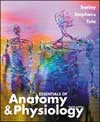 |  Essentials of Anatomy & Physiology, 4/e Rod R. Seeley,
Idaho State University
Philip Tate,
Phoenix College
Trent D. Stephens,
Idaho State University
Tissues, Glands, and Membranes
Study OutlineEpithelial Tissue
Functions of Epithelia
Protecting underlying structures
Acting as barriers
Permitting the passage of substances
Secreting substances
Absorbing substances
General characteristics(Fig. 4.1, p. 72)Classification(Table 4.1, p. 73)Simple squamous epithelium(Fig. 4.2A, p. 73)Simple cuboidal epithelium(Fig. 4.2B, p. 74)Simple columnar epithelium(Fig. 4.2C, p. 74)Pseudostratified columnar epithelium(Fig. 4.2D, p. 75)Stratified squamous epithelium(Fig. 4.2E, p. 75)Transitional epithelium(Fig. 4.2F, p. 76) Structural and Functional Relationships
Cell Layers and Cell Shapes
Stratified-protective
Simple-diffusion, filtration, secretion, absorption
Thin, flat-diffusion
Cuboidal and columnar-secretion and absorption
Free Cell Surfaces
Smooth
Microvilli
Cilia and
Goblet cells
Cell Connections(Fig. 4.3, p. 77)Tight junctions
Desmosomes
Gap junctions
Glands
Exocrine glands(Fig. 4.4, p. 78)Unicellular gland
Simple straight tubular gland
Simple coiled tubular gland
Simple acinar or alveolar gland
Simple branched acinar
Compound tubular gland
Compound acinar or alveolar gland
Endocrine glands
Connective Tissue
General Characteristics(Table 4.2, p. 79)Extracellular matrix
Protein fibers
Collagen fibers
Reticular fibers
Elastic fibers
Ground substance-proteoglycans
Fluid Cell functions
Blast cells
Cyte cells
Clast cells
Macrophages and mast cells
Functions of Connective Tissue
Enclosing and separating
Connecting tissues to one another
Supporting and moving
Storing
Cushioning and insulating
Transporting
Protecting
Classification(Table 4.2, p. 80)Matrix with Protein Fibers as the Primary Feature
Dense connective tissue
Collagenous connective tissue(Fig. 4.5A, p. 80)Elastic connective tissue
Loose or areolar connective tissue(Fig. 4.5B, p. 81)Special - Adipose tissue (fat)(Fig. 4.5C, p. 81) Matrix with both Protein Fibers and Ground Substance
Cartilage(Fig. 4.5D, p. 82)Hyaline cartilage(Fig. 4.5E, p. 82)Fibrocartilage(Fig. 4.5F, p. 83)Elastic cartilage(Fig. 4.5G, p. 83) Bone
Compact bone(Fig. 4.5H, p. 84) Cancellous bone
Fluid Matrix - Blood(Fig. 4.5I, p. 84) Muscle Tissue
Muscle cells (fibers) have contraction capability
Three types
Skeletal muscle(Fig. 4.6A, p. 85)Cardiac muscle(Fig. 4.6B, p. 86)Smooth muscle(Fig. 4.6C, p. 86) Nervous Tissue(Fig. 4.7, p. 87)Neuron or nerve cell
Neuroglia
Membranes
Mucous membranes
Serous membranes (Fig. 1.12, 1-13, p. 15)Pleural membranes-pleurisy
Pericardial membranes-pericarditis
Peritoneal membranes-peritonitis
Other membranes
Cutaneous membrane
Synovial membrane
Periosteum
Inflammation(Fig. 4.8, p. 89)Symptoms
Redness
Heat
Swelling
Pain
Disturbance of function
Mechanisms
Mediators of inflammation
Edema
Neutrophils and pus
Tissue Repair(Fig. 4.9, p. 90)Processes
Regeneration
Replacement
Cell types
Labile cells
Stable cells
Permanent cells
Granulation tissue and wound contracture
Systems Pathology - Cancer: Malignanat MelanomaSystems Interactions Table,
p.92
|
|



 2002 McGraw-Hill Higher Education
2002 McGraw-Hill Higher Education